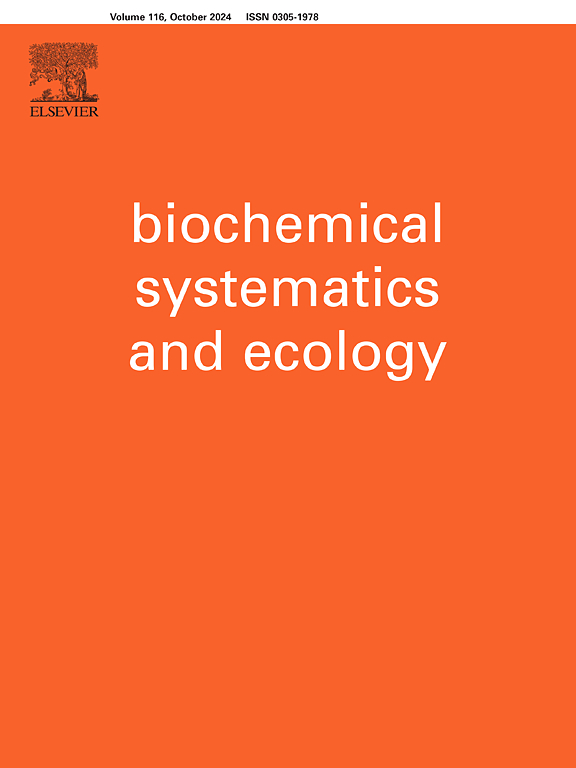Chloranthus japonicus Sieb.(Chloranthus japonicus Sieb:)代谢物结构多样性和药理学综述
IF 2
4区 生物学
Q4 BIOCHEMISTRY & MOLECULAR BIOLOGY
引用次数: 0
摘要
Chloranthus japonicus Sieb.(日本绿萝(Chloranthaceae)是一种药用亚洲植物,具有有趣的植物化学成分。本研究旨在对日本绿萝的植物化学以及次生代谢物在药理学中的作用进行全面深入的综述。通过色谱柱,研究人员分离并阐明了 207 种化合物的结构,其中包括多种倍半萜类化合物。Chlojaponilide M、cycloshizukaol A、chlojapolactone A、hitorins A-H、japonicones A-C 和 trishizukaol A 等几种化合物是日本忍冬的特征代谢物。日本忍冬的成分具有多种生物价值,如抗癌、抗微生物、抗病毒、抗炎、抗肥胖和新陈代谢活性,这也有利于日本忍冬成分的药物开发。有些分离制剂本身就具有潜力,因为它们比阳性对照组更好。NF-κB(核因子卡巴 B)是药理学探索的基本分子机制之一。总之,有必要对日本忍冬的成分,尤其是椴树烷类倍半萜进行广泛的体外和体内生物医学研究。本文章由计算机程序翻译,如有差异,请以英文原文为准。
Chloranthus japonicus Sieb. (Chloranthaceae): A review of metabolite structural diversity and pharmacology
Chloranthus japonicus Sieb. (the family Chloranthaceae) is a medicinal Asian plant with interesting phytochemicals. The current study aims to comprehensively provide an in-depth review of phytochemistry, and the role of C. japonicus secondary metabolites in pharmacology. Using chromatographic columns, 207 compounds have been isolated and structurally elucidated with a diversity of sesquiterpenoids. Several compounds, such as chlojaponilide M, cycloshizukaol A, chlojapolactone A, hitorins A-H, japonicones A-C, and trishizukaol A were characteristic metabolites of C. japonicus. It also brings benefits in the use of C. japonicus constituents for drug development, in which they possess various biological values, such as anticancer, anti-microbial, anti-virus, anti-inflammation, anti-obesity, and metabolic activities. Some isolated agents themselves have potential since they are better than the positive controls. The NF-κB (nuclear factor kappa B) is one of the underlying molecular mechanisms for pharmacological exploration. Collectively, extensive in vitro and in vivo biomedical studies on C. japonicus constituents, especially lindenane-type sesquiterpenoids, are necessary.
求助全文
通过发布文献求助,成功后即可免费获取论文全文。
去求助
来源期刊

Biochemical Systematics and Ecology
生物-进化生物学
CiteScore
3.00
自引率
12.50%
发文量
147
审稿时长
43 days
期刊介绍:
Biochemical Systematics and Ecology is devoted to the publication of original papers and reviews, both submitted and invited, in two subject areas: I) the application of biochemistry to problems relating to systematic biology of organisms (biochemical systematics); II) the role of biochemistry in interactions between organisms or between an organism and its environment (biochemical ecology).
In the Biochemical Systematics subject area, comparative studies of the distribution of (secondary) metabolites within a wider taxon (e.g. genus or family) are welcome. Comparative studies, encompassing multiple accessions of each of the taxa within their distribution are particularly encouraged. Welcome are also studies combining classical chemosystematic studies (such as comparative HPLC-MS or GC-MS investigations) with (macro-) molecular phylogenetic studies. Studies that involve the comparative use of compounds to help differentiate among species such as adulterants or substitutes that illustrate the applied use of chemosystematics are welcome. In contrast, studies solely employing macromolecular phylogenetic techniques (gene sequences, RAPD studies etc.) will be considered out of scope. Discouraged are manuscripts that report known or new compounds from a single source taxon without addressing a systematic hypothesis. Also considered out of scope are studies using outdated and hard to reproduce macromolecular techniques such as RAPDs in combination with standard chemosystematic techniques such as GC-FID and GC-MS.
 求助内容:
求助内容: 应助结果提醒方式:
应助结果提醒方式:


